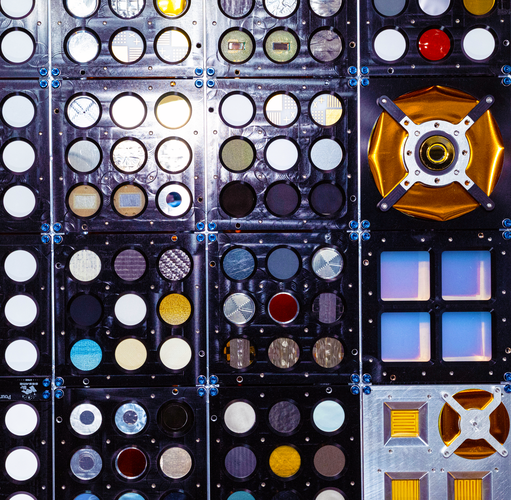Nothing is entirely immune to the harsh environment of space. Out there, things and organisms degrade at a faster pace and in different ways. To understand how materials age beyond Earth’s atmosphere, up to 141 samples are spending a minimum of six months exposed to outer space for the Euro Material Ageing experiment.
Radiation, vacuum, temperature extremes and even space debris are hitting this selection of inorganic materials on Bartolomeo, Europe’s ‘front porch’ on the International Space Station.
No filters or protection allowed, each sample has a bare surface of 20 millimetres cramped between two aluminium plates. The diverse palette in this image shows metallic glass, ceramic composites, silicon, diamond-like carbon, carbon fibres and plastics, among others.
Europe has years of experience in sending biology samples to space, but this is the first time ESA and the French space agency CNES expose inorganic materials outside the Space Station.
NASA astronauts Sunita Williams and Nick Hague used the Station’s 17-metre-long robotic arm last December to place the Nanoracks airlock on Bartolomeo, where the experiment is facing the full spectrum of space environment hazards.
As Nick Hague said in a social media post, “Materials research is critical to our exploration of space. Vacuum, extreme hot and cold, radiation – these are the harsh realities of the space environment. The right materials can help us survive in space and dare to go further, and can also improve life on Earth!”
Euro Material Ageing is testing how exposure to space can be bad for the health of spacecraft components. Whether a mission is orbiting Earth or operates in deep space, unwanted effects include discoloration, embrittlement and buckling.
The Space Station experiences frequent changes from sunlight to darkness while circling our planet. Materials go through drastic temperature shifts from up to 150°C in sunlight down to –150°C in the shade. Such thermal stresses lead to accelerated ageing, potential cracking and misalignment.
Samples are exposed to highly reactive atomic oxygen formed at the topmost fringes of the atmosphere and known to eat away satellite surfaces. Materials in this experiment will also cope with ‘outgassing’ in vacuum – the gradual boiling away of chemicals and solvents – which could contaminate sensitive satellite surfaces such as lenses.
Results from the Euro Material Ageing experiment could inform the design of fire-retardant and rust-resistant materials, and better protection for satellites could in turn help improve plastic siding for your house.
The exposure time is planned between six and 18 months. After completion, the facility will be transferred back inside the International Space Station. A new set of samples will be waiting for a second immersion into the harshness of space.



 Image:
In a materials world
Image:
In a materials world